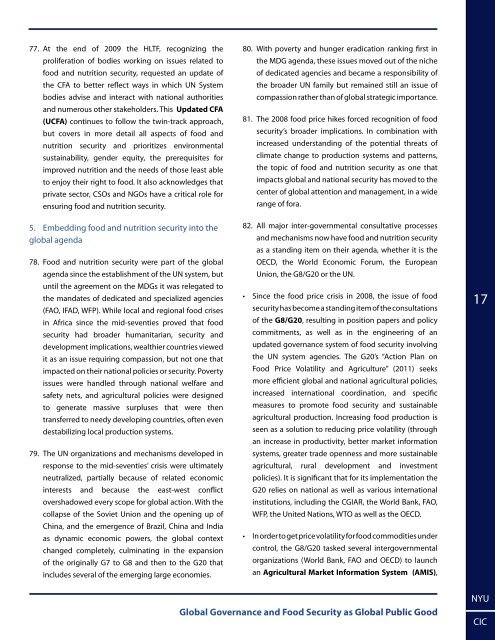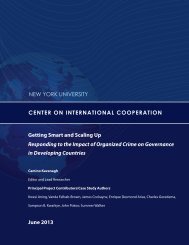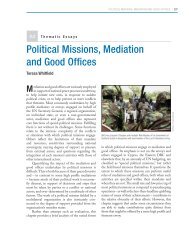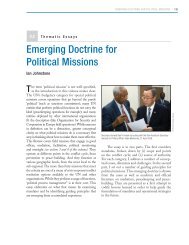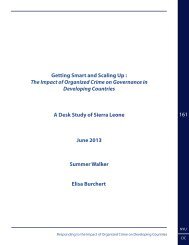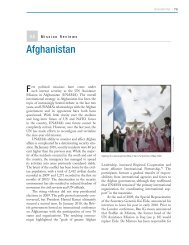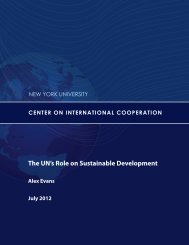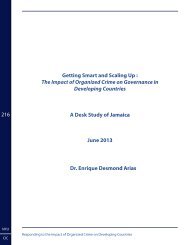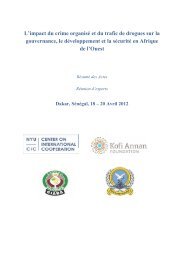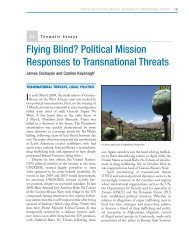16• The World Summit on <strong>Food</strong> <strong>Security</strong> (Rome 2009)built on the AFSI approach with its “Five Rome Principlesfor Sustainable <strong>Global</strong> <strong>Food</strong> <strong>Security</strong>”. 38 Particularemph<strong>as</strong>is w<strong>as</strong> given to investment in country-ownedplans.• The pledges made through the L’Aquila <strong>Food</strong> <strong>Security</strong>Initiative led to the establishment of the <strong>Global</strong>Agriculture <strong>and</strong> <strong>Food</strong> <strong>Security</strong> Program (GAFSP) 39Trust Fund, a multilateral financing mechanism runthrough the World Bank focused on the achievement ofMDG1. Its objective w<strong>as</strong> to address the underfundingof country <strong>and</strong> regional agriculture <strong>and</strong> food securitystrategic investment plans already under development.Launched by the UN Secretary-General (Madrid 2009),its m<strong>and</strong>ate w<strong>as</strong> on building on existing structures <strong>and</strong>supporting the implementation of the CFA, throughwork at global <strong>and</strong> national levels. It consists of apublic <strong>and</strong> private sector window <strong>and</strong> reports to havereceived commitments of USD1 billion (March 2013)from eight donors including the Gates foundation. TheGAFSP works with existing processes <strong>and</strong> institutions<strong>and</strong> is coordinated by a secretariat, housed at theInternational Fund for Agricultural Development (IFAD)in Rome <strong>and</strong> formed by the HLTF.• The Framework for Scaling-Up Nutrition (SUN) 40is a multi-stakeholder movement (W<strong>as</strong>hington April2010) focusing on nutrition-specific interventions <strong>and</strong>actions during the first 1000 days of individual growth.It advocates incorporating specific pro-nutritionactions into other sectors <strong>and</strong> development are<strong>as</strong> such<strong>as</strong> health, food security <strong>and</strong> agriculture, gender, socialprotection, education, <strong>and</strong> water <strong>and</strong> sanitation, <strong>and</strong>includes marginalized populations, especially women.38. “In November 2009, the World Summit on <strong>Food</strong> <strong>Security</strong> in Rome adopted the “Five RomePrinciples for Sustainable <strong>Global</strong> <strong>Food</strong> <strong>Security</strong>” b<strong>as</strong>ed on the “L’Aquila Joint Statement on<strong>Global</strong> <strong>Food</strong> <strong>Security</strong>” issued at the G8+ Summit 2009: Principle 1: Invest in country-owned plans,aimed at channeling resources to well-designed <strong>and</strong> results b<strong>as</strong>ed programmes <strong>and</strong> partnerships.Principle 2: Foster strategic coordination at national, regional <strong>and</strong> global level to improvegovernance, promote better allocation of resources, avoid duplication of efforts <strong>and</strong> identifyresponse gaps. Principle 3: Strive for a comprehensive twin-track approach to food securitythat consists of: 1) direct action to immediately tackle hunger for the most vulnerable <strong>and</strong> 2)medium- <strong>and</strong> long-term sustainable agricultural, food security, nutrition <strong>and</strong> rural developmentprogrammes to eliminate the root causes of hunger <strong>and</strong> poverty, including the progressiverealization of the right to adequate food. Principle 4: Ensure a strong role for the multilateralsystem by sustained improvements in efficiency, responsiveness, coordination <strong>and</strong> effectivenessof multilateral institutions. Principle 5: Ensure sustained <strong>and</strong> substantial commitment by allpartners to investment in agriculture <strong>and</strong> food <strong>and</strong> nutrition security, with the provision ofnecessary resources in a timely <strong>and</strong> reliable f<strong>as</strong>hion, aimed at multi-year plans <strong>and</strong> programmes.These serve <strong>as</strong> a b<strong>as</strong>is for turning political commitments into action <strong>and</strong> outcomes at communitylevel.” Source: Updated Comprehensive Framework for Action, HLTF, 200939. www.gafspfund.org/gafsp/content/global-agriculture-<strong>and</strong>-food-security-program40. scalingupnutrition.org/Its aim is to support SUN countries in realizing nationalnutrition goals <strong>and</strong> targets, including the MDG-1 target.Many countries have also developed specific nutritiontargets for the years beyond 2015. SUN is led by ahigh-level, multi-stakeholder Lead Group appointedby the UN Secretary-General. The SUN movement h<strong>as</strong>developed considerable momentum: starting initiallywith three countries in mid-2012, by early 2013, 34countries have signed up <strong>and</strong> over 100 organizations<strong>and</strong> entities have signaled their support.• One of the most important actions by the internationalcommunity h<strong>as</strong> been the reform <strong>and</strong> transformation ofthe Committee on World <strong>Food</strong> <strong>Security</strong> (CFS). 41 TheCFS w<strong>as</strong> set up in 1974 <strong>as</strong> an intergovernmental bodyfor review <strong>and</strong> follow-up on food security policies. In2009 it w<strong>as</strong> reformed to become the most inclusiveinternational <strong>and</strong> intergovernmental platform for allstakeholders of food <strong>and</strong> nutrition security to worktogether in a coordinated way. Even though the reformw<strong>as</strong> triggered by the 2008 food crisis, it enabled theCFA to also deal with long term structural issues. TheCFS reports annually to Economic <strong>and</strong> Social Councilof the United Nations (ECOSOC) <strong>and</strong> the expectationis that Member States participate in CFS sessions atthe highest level possible. In practice, participation isvery wide-ranging with participants from UN agencies<strong>and</strong> bodies, civil society <strong>and</strong> non-governmentalorganizations <strong>and</strong> their networks, internationalagricultural research systems, international <strong>and</strong>regional financial institutions <strong>and</strong> representatives ofprivate sector <strong>as</strong>sociations <strong>and</strong> private philanthropicfoundations. It is supported by an independent HighLevel Panel of Experts on <strong>Food</strong> <strong>Security</strong> <strong>and</strong> Nutrition(HLPE) (established 2009), which w<strong>as</strong> introduced <strong>as</strong> anessential part of the CFS reform. The CFS, along with theHLPE, h<strong>as</strong> also been described <strong>as</strong> a “central componentof the evolving GAFSP” providing the political <strong>and</strong>scientific arms of the partnership, while the GAFSPprovides its financial arm. The reformed CFS h<strong>as</strong> begunwork on several important topics including food pricevolatility <strong>and</strong> voluntary guidelines on l<strong>and</strong> tenure.41. www.fao.org/cfs/cfs-home/en/NYUCIC<strong>Global</strong> <strong>Governance</strong> <strong>and</strong> <strong>Food</strong> <strong>Security</strong> <strong>as</strong> <strong>Global</strong> <strong>Public</strong> <strong>Good</strong>
77. At the end of 2009 the HLTF, recognizing theproliferation of bodies working on issues related tofood <strong>and</strong> nutrition security, requested an update ofthe CFA to better reflect ways in which UN Systembodies advise <strong>and</strong> interact with national authorities<strong>and</strong> numerous other stakeholders. This Updated CFA(UCFA) continues to follow the twin-track approach,but covers in more detail all <strong>as</strong>pects of food <strong>and</strong>nutrition security <strong>and</strong> prioritizes environmentalsustainability, gender equity, the prerequisites forimproved nutrition <strong>and</strong> the needs of those le<strong>as</strong>t ableto enjoy their right to food. It also acknowledges thatprivate sector, CSOs <strong>and</strong> NGOs have a critical role forensuring food <strong>and</strong> nutrition security.5. Embedding food <strong>and</strong> nutrition security into theglobal agenda78. <strong>Food</strong> <strong>and</strong> nutrition security were part of the globalagenda since the establishment of the UN system, butuntil the agreement on the MDGs it w<strong>as</strong> relegated tothe m<strong>and</strong>ates of dedicated <strong>and</strong> specialized agencies(FAO, IFAD, WFP). While local <strong>and</strong> regional food crisesin Africa since the mid-seventies proved that foodsecurity had broader humanitarian, security <strong>and</strong>development implications, wealthier countries viewedit <strong>as</strong> an issue requiring comp<strong>as</strong>sion, but not one thatimpacted on their national policies or security. Povertyissues were h<strong>and</strong>led through national welfare <strong>and</strong>safety nets, <strong>and</strong> agricultural policies were designedto generate m<strong>as</strong>sive surpluses that were thentransferred to needy developing countries, often evendestabilizing local production systems.79. The UN organizations <strong>and</strong> mechanisms developed inresponse to the mid-seventies’ crisis were ultimatelyneutralized, partially because of related economicinterests <strong>and</strong> because the e<strong>as</strong>t-west conflictovershadowed every scope for global action. With thecollapse of the Soviet Union <strong>and</strong> the opening up ofChina, <strong>and</strong> the emergence of Brazil, China <strong>and</strong> India<strong>as</strong> dynamic economic powers, the global contextchanged completely, culminating in the expansionof the originally G7 to G8 <strong>and</strong> then to the G20 thatincludes several of the emerging large economies.80. With poverty <strong>and</strong> hunger eradication ranking first inthe MDG agenda, these issues moved out of the nicheof dedicated agencies <strong>and</strong> became a responsibility ofthe broader UN family but remained still an issue ofcomp<strong>as</strong>sion rather than of global strategic importance.81. The 2008 food price hikes forced recognition of foodsecurity’s broader implications. In combination withincre<strong>as</strong>ed underst<strong>and</strong>ing of the potential threats ofclimate change to production systems <strong>and</strong> patterns,the topic of food <strong>and</strong> nutrition security <strong>as</strong> one thatimpacts global <strong>and</strong> national security h<strong>as</strong> moved to thecenter of global attention <strong>and</strong> management, in a widerange of fora.82. All major inter-governmental consultative processes<strong>and</strong> mechanisms now have food <strong>and</strong> nutrition security<strong>as</strong> a st<strong>and</strong>ing item on their agenda, whether it is theOECD, the World Economic Forum, the EuropeanUnion, the G8/G20 or the UN.• Since the food price crisis in 2008, the issue of foodsecurity h<strong>as</strong> become a st<strong>and</strong>ing item of the consultationsof the G8/G20, resulting in position papers <strong>and</strong> policycommitments, <strong>as</strong> well <strong>as</strong> in the engineering of anupdated governance system of food security involvingthe UN system agencies. The G20’s “Action Plan on<strong>Food</strong> Price Volatility <strong>and</strong> Agriculture” (2011) seeksmore efficient global <strong>and</strong> national agricultural policies,incre<strong>as</strong>ed international coordination, <strong>and</strong> specificme<strong>as</strong>ures to promote food security <strong>and</strong> sustainableagricultural production. Incre<strong>as</strong>ing food production isseen <strong>as</strong> a solution to reducing price volatility (throughan incre<strong>as</strong>e in productivity, better market informationsystems, greater trade openness <strong>and</strong> more sustainableagricultural, rural development <strong>and</strong> investmentpolicies). It is significant that for its implementation theG20 relies on national <strong>as</strong> well <strong>as</strong> various internationalinstitutions, including the CGIAR, the World Bank, FAO,WFP, the United Nations, WTO <strong>as</strong> well <strong>as</strong> the OECD.• In order to get price volatility for food commodities undercontrol, the G8/G20 t<strong>as</strong>ked several intergovernmentalorganizations (World Bank, FAO <strong>and</strong> OECD) to launchan Agricultural Market Information System (AMIS),17<strong>Global</strong> <strong>Governance</strong> <strong>and</strong> <strong>Food</strong> <strong>Security</strong> <strong>as</strong> <strong>Global</strong> <strong>Public</strong> <strong>Good</strong>NYUCIC


